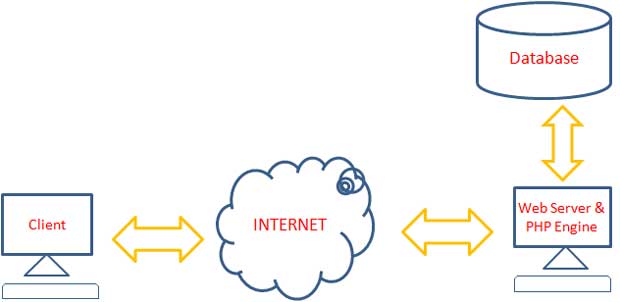Starting with PHP & MySQL
PHP: It is the script or language
PHP is used to connect to database, display the results or manage the records of the database. PHP is the server side scripting language and to know more about it and how PHP work you can visit our PHP introduction page. To get the full detail of PHP components working in the server you can use PHP command phpinfo. PHP works equally well with MSSQL, Oracle and other databases available. We will discuss more on MySQL here.
MySQL: It is the database
It stores tables, support queries to manage its data. We keep all our records in MySQL database. MySQL can be downloaded from www.mysql.org. MySQL database is very powerful and can be used in real word demanding projects. Different version of MySQL is available for different platforms.MySQL once installed runs as a server in the local machine or in any remote server. User can connect to the local or remote MySQL server by using the server name or IP address based on the privilege they have. Once connected users can manipulate the MySQL database by using different PHP commands. You will learn many such PHP commands here.
Installing both depends on the platform you use. In windows system like any other software you can install both. Read the PHP section on how to install
Testing MYSQL drivers and PHP support
In your PHP installation you must have supported DLL or drivers to manage database. Here is the code you can run in your PHP installed directory or on your localhost to find out the supports for MySQL database.After placing the folder in your server open the file mysql.php , then visit the link at bottom to check PHP installation information.
<?Php
/////////Checking MySLQI /////////
if (function_exists('mysqli_connect')) {
echo "<h2><font color=green>mysqli support is available</font></h2>";
}else{
echo " <h2><font color=red>mysqli support is NOT available</font></h2> ";
}
//////// Checking PDO //////
if(in_array("mysql",PDO::getAvailableDrivers())){
echo "<h2><font color=green>PDO for MySQL driver is installed</font></h2>";
}else{
echo " <h2><font color=red>PDO driver for MySQL is NOT installed</font></h2> ";
}
/////////Checking MySQL /////
if (function_exists('mysql_connect')) {
echo "<h2><font color=green>mysql support is available</font></h2>";
}else{
echo " <h2><font color=red>mysql support is NOT available</font></h2> ";
}
?>
Managing MySQL
After installing MySQL and your localhost, you can manage MySQL database by using PHPmyAdmin . Once our setup is ready we will try to run our SQL from PHP scriptsExecuting query in PHP
We will learn how to write a query and using PHP function how to execute the query. This process will ensure that all data connections are established and from PHP script we can manage the data stored in MySQL.Displaying Records
We will start with the most simple job of displaying records or data from MySQL table by using PHP. There are several ways to do this and as per our requirement we can collect single or multiple records from the tables to display.Displaying single Records
We can display all details of a record in a page. Displaying a single product or showing profile of a member can be done by using MySQLi or PDO connections.Displaying records with Edit option
Each record will have one Edit button for the user to update dataShowing more details of record on click ( expand ) by user
We can display minimal information line name or id to the user and on click we can further expand it to display full details of the record.Paging of records
When we have more records to display we cant show all at same time. We can display fixed numbers or a set of records per page by giving navigation to previous or next set of records. We call it paging.PDO: Portable Data Object
We can use PDO to connect to various data sources and we will discuss more on MySQL connection hereMYSQLI: MySQL Improved
Manage MySQL database using MySQLi functionsDisplaying Images from MySQL Records
Display images with other data from MySQL table by using MySQL or PDODelete Images from MySQL Records
Add Images with details to MySQL Records
Displaying records without repetitions of same field data
phpinfo() to get MySQL support
Legacy php mysql connection
Exercise on PHP MySQL
Subscribe to our YouTube Channel here
This article is written by plus2net.com team.
https://www.plus2net.com

| abc | 16-11-2014 |
| how can i pass textbox value in another php script with using url when click on submit button | |
| Smo | 31-05-2015 |
| This is done by using Form. You can read more on this in our HTML form section | |
| prags | 27-01-2016 |
| how can i fetch the records from one table of dropdown list and store it in another table using join in php | |
| smo1234 | 31-01-2016 |
| You can collect records by using select query and then insert the same in another table, you can also directly use insert into command to use data from one table and store in another table. | |
| gin | 13-02-2016 |
| When selecting a name from a drop down menu of my DB table, how can I display the remaining names of my same DB table on another drop down menu? For example, if I select John from the drop down menu, his name won't be available on the second drop down menu. | |
| smo1234 | 13-02-2016 |
| You can remove that name by using WHERE condition in the query your use to populate second list. SELECT * from Table_list WHERE name !='Name_to_remove' | |
| osei pious | 01-05-2017 |
| how many data base do I need to make a complete website? | |
| smo1234 | 02-05-2017 |
| One database. Need more tables to store different type of records. | |
